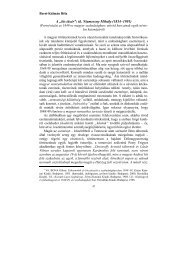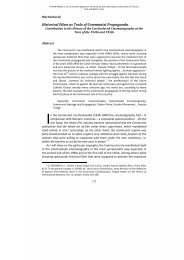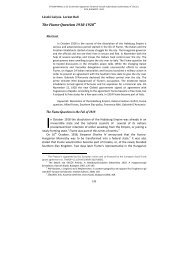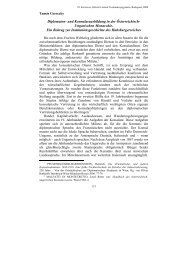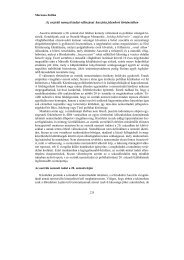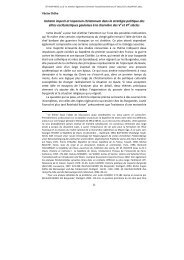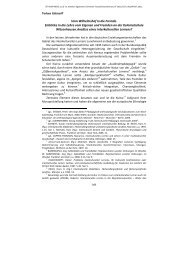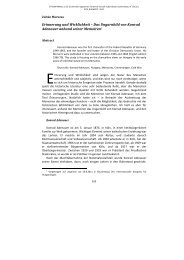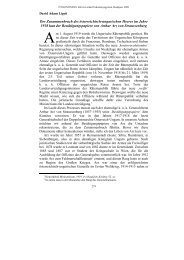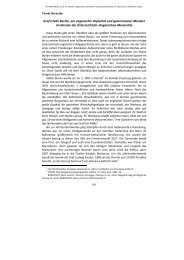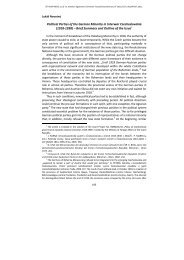The Molotov-Ribbentrop Pact - ELTE BTK Történelem Szakos Portál
The Molotov-Ribbentrop Pact - ELTE BTK Történelem Szakos Portál
The Molotov-Ribbentrop Pact - ELTE BTK Történelem Szakos Portál
Create successful ePaper yourself
Turn your PDF publications into a flip-book with our unique Google optimized e-Paper software.
the „capitalist fascist” camp”. „Here the transformation is fundamental. No<br />
doubt this policy still poses a problem today since it is much less<br />
understandable than the precise point of a simple pact of non-agression” 10 .<br />
More recently, it is the alliance which is highlighted by French historians.<br />
Thus, François Furet writes: „the pact of August 23 inugurates the period of<br />
alliance between the USSR and Nazi Germany. An alliance and not simply an<br />
agreement of non-agression, according to the first presentation which was<br />
made at the time…” 11 . As for Stéphane Courtois, in his introduction (which<br />
gave rise to so many reactions) to the Black Book of Communism, devoted to<br />
„the crimes of Communism”, he asserts that: „Stalin undeniably committed this<br />
type of crime („against peace”), even simply by secret negotiations with Hitler,<br />
through two peace treaties on August 23 and September 28, 1939, the division<br />
of Poland and the annexion of the Baltic states, of Northern Bukovine and of<br />
Bessarabia by the USSR” 12 .<br />
Thus, in half a century, the <strong>Ribbentrop</strong>-<strong>Molotov</strong> pact has been read less and less<br />
as a „simple” diplomatic treaty but as a strong political act implying Staline, the<br />
USSR and Communism by insisting on the serious Soviet responsibility. <strong>The</strong><br />
second analysis has gained a predominant position since the 1990s, which is to say<br />
after the fall of the USSR, in the context of the collapse and of the denunciation of<br />
past Communist history. <strong>The</strong> wording used by Stéphane Courtois in his conference<br />
of the summer of 2009 is, in this respect, explicit and summarizes this evolution:<br />
the „German-Soviet pact” was replaced by „the Soviet-Nazi alliance”. <strong>The</strong>se terms<br />
of course point to different interpretations of the reasons which led to the signing of<br />
the texts during the summer of 1939.<br />
At the origins of the „German-Soviet pact” or „the appearance of the<br />
defendants” (Y. Santamaria): Staline as the main culprit?<br />
From the first texts on the German-Soviet pact, historians wondered about<br />
the motivations of the signees, Nazi Germany and the Soviet Union, „two states<br />
whose deep inimity had been, since the coming to power of Hitler, a constant in<br />
international politics” 13 . But they also questioned more and more the<br />
responsibilities of Western democracies and of Poland.<br />
Concerning the reasons which led Hitler to accept the negotiations and then the<br />
agreement with Staline, at the request of <strong>Ribbentrop</strong>, historiography has not really<br />
evolved. Indeed, „differences in opinion on Hitler’s assessment of the Soviet<br />
threat” 14 do exist. But, very early on, a wide consensus appeared: as P. Renouvin<br />
wrote: „the motives of the German policy were not dubious” since the „German-<br />
10 GIRAULT, René: art.cité, 112.<br />
11 FURET, François: op.cit., 365.<br />
12 COURTOIS, Stéphane: Le livre noir…op.cit., 15.<br />
13 RENOUVIN, Pierre: Histoire des relations…op.cit., 180.<br />
14 SANTAMARIA, Yves: op.cit., 121.<br />
26



